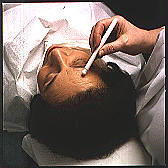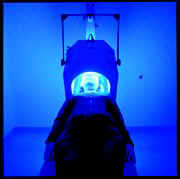|
|
|
Patient Information: I have actinic keratosis what can I do?
Once you have been diagnosed with actinic keratosis there are several effective treatments to choose from. However to decide which treatment may best apply to your specific situation should be discussed with your doctor.
Cryosurgery
Cryosurgery is the most common treatment for actinic keratosis. Here liquid nitrogen is applied to the affected surface with a cotton tip applicator or spray device. Liquid nitrogen is extremely cold (-195,8 °C = -320,44 °F) and will cause death of all cells of this area.
Advantages of the treatment
- It is a highly effective treatment.
- It is a quick procedure.
- It only requires one or two visits to the doctor.
- In general it is a rather cheap treatment. (?)
Disadvantages of the treatment
- The treatment causes discomfort and/or pain.
- Due to freezing the skin may presumably react with blisters, reddening, swelling or a change of color in skin patches.
- An infection may occur due to delayed wound-healing.
- There is a risk of scarring.
Curettage
Curettage describes the scraping away of a superficial skin disorder. Usually a scalpel or another sharp device, called a curette, is used for scraping.
Advantages of the treatment
- It is an effective treatment.
Disadvantages of the treatment
- The treatment usually requires a local anesthetic.
- Occasionally, a change of color or an infection of the skin may occur.
- There is a possibility of scarring.
Topical 5-fluorouracil
Topical 5-fluorouracil, also called 5-FU, is a cream that is applied to the skin. It contains a drug that will cause cell death by binding to cellular DNA.
Advantages of the treatment
- It is a highly effective treatment.
- It has good cosmetic results.
Disadvantages of the treatment
- In general the treatment is rather painful and disfiguring due to inflammation and reddening of the area. If a large area is treated it may be quite disfiguring.
- The cream has to be applied over quite a long period (appoximately 2 to 4 weeks).
- The success of treatment depends on patient cooperation.
Photodynamic therapy
Photodynamic therapy is based on a chemical reaction of a drug induced by light that will kill abnormal cells. The drug will be absorbed by the skin cells and will cause sensitivity of the skin towards light of a certain color/wavelenght. If light is induced to the treated area a chemical reaction is initiated that will lead to the death of diseased cells. The drug most often used is called aminolevulinic acid (ALA).
|
 |
 |
 |
 |
Advantages of the treatment
The treatment is highly effective and does not require surgery.
It has excellent cosmetic results.
Usually the treated areas heal fast (within two weeks).
Only one or two treatments are necessary.
Disadvantages of the treatment
- The treatment will cause a typical photodynamic reaction such as stinging, burning, itching, reddening and/or swelling.
- Pain during irradiation may require anesthesia
|
Other treatments
Besides the treatments mentioned above there are several others in use.
Medication
There are several drugs used to treat actinic keratosis. These are basically divided into drugs that are applied to the skin – so-called topical drugs – and drugs that need to be taken orally, so-called systemical drugs.
Topical drugs such as:
Salicylic acid, topical retinoids, alpha hydroxy acids, topical masoprocol, topical tubercidin, chemical or cryosurgical peel, imiquimod (experimental)
Systemic drugs such as:
Oral retinoids (often in combination with 5-FU), Interferon
Surgery
Excisional surgery is an intervention where the lesion is simply cut out, whereas dermabrasion is an intervention where the top layers of the affected skin area are ground away.
Laser
Affected cells are destroyed by the laser.
|
|

|
|

|
|
